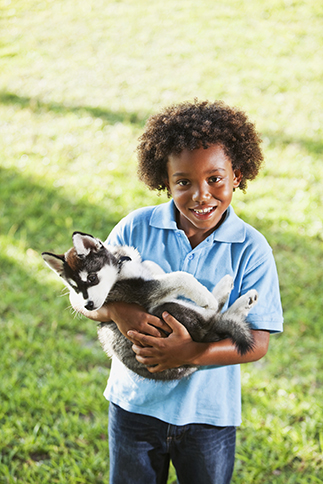Kids and animals
The benefit of pets for children
 Kids and animals build wonderful relationships and they often share a very special bond. With a family pet in the household, children learn how to be around animals at a young age. They also learn about responsibility through the process of looking after a pet. Find out the positive effects a pet can have on kids. Parents and children can enjoy playtime together along with the family pet – helping your kids to understand animals and their behaviour.
Kids and animals build wonderful relationships and they often share a very special bond. With a family pet in the household, children learn how to be around animals at a young age. They also learn about responsibility through the process of looking after a pet. Find out the positive effects a pet can have on kids. Parents and children can enjoy playtime together along with the family pet – helping your kids to understand animals and their behaviour.
Is it safe to have pets around your baby?
If you have had a pet for some time, they would have already established a relationship with you and a status in your household. So naturally you would wonder how your animal companion would react when you bring your newborn home.
Make the association to your baby a positive one and remember to give your pet some attention too during this busy time. To make the adjustments easier on your dog or cat, let them get used to the new ground rules before baby arrives.
Find the opportunity to bring home an item with your baby’s scent on it so they can be familiarised with it before you bring your newborn home. If you are concerned about the safety of your baby around your pets, see babies and dogs and babies and cats for more information.
How do I choose the right pet for my family?
Kids will often express an interest in a particular animal at a young age. Apart from the obvious no-no’s like dolphins and dinosaurs, take your child’s wishes into account, but ultimately choose a pet that is right for your family.
When choosing a family pet, base your decision on what will be suitable not only for your kids, but their parents too. Take into consideration the responsibility and costs involved, and make a decision based on the size of the home and your family’s lifestyle as well. Think about what will be suitable according to the age of your children.
Small pets like fish, rabbits, guinea pigs or mice are great fun, easy to handle and will cost you less to maintain. Kids love to watch and observe so having an ant farm or a bowl of sea monkeys can provide hours of entertainment. When it comes to having a reptile like a snake or lizard as a pet, make sure you are prepared to provide the suitable types of food. A common diet for reptiles would involve insects and worms.
For larger animals, like cats and dogs, try and find how they behave around children. Behavioural issues in pets can have a negative impact on children. Dogs generally make good companions for kids, but bear in mind that when choosing a canine you should understand the temperament of the breed. Same goes for cats – while some breeds are playful and adapt well to children, others are just not that sociable when it comes to kids. If in doubt, check with your local vet or ask a breeder whether the breed of dog is kid friendly.
When you have decided on a pet, teach your kids how they should be handling them. And for health and hygiene reasons, make it an early habit for your kids to always wash their hands after playing or feeding their pet.
Children and animals
When it comes to kids and animals, child safety is important! Having a family pet is a great way for children to learn about animals – but make sure your kids are aware other dogs or cats may behave differently to their own. While it might seem like a fun game to take away pooch’s bone or pull on kitty’s tail, certain behaviour should be avoid as a safety measure. Kids will often come across the opportunity to interact with animals even if they don’t have a pet at home. So it’s a good idea to teach children the importance of respecting animals and to be able to recognise and avoid threatening behaviour in animals. For more information about kids and animals, see cats and children and dog bite prevention.
For more information see Parenting.

